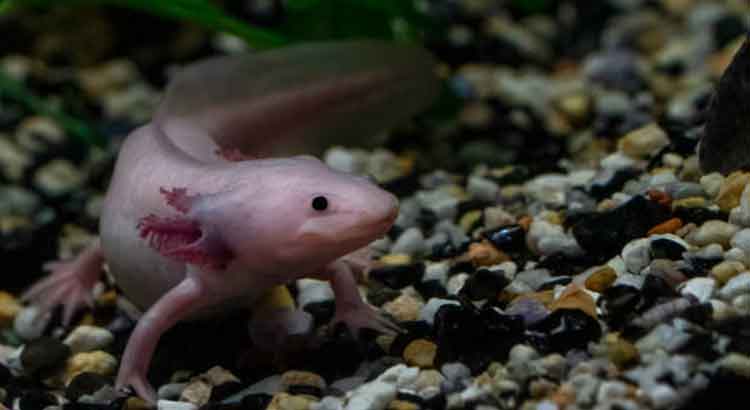Do your eyes widen at the thought of a purple axolotl? Wondering if these stunning creatures are real or just a delightful hoax? Dive into the truth behind the vibrant hue.
Purple axolotls are purely fictional creations. Despite their alluring appearance, there’s no evidence of their existence in the natural world.
Discover the captivating world of axolotls and unravel the mystique behind their enchanting colors. Learn about these fascinating amphibians and the science behind their mesmerizing hues.
The Myth of Purple Axolotls
Purple axolotls: a whimsical creation sparking curiosity. Yet, these vibrant amphibians exist solely in the realms of imagination. Despite the allure of photographs circulating online, there’s no factual basis for their existence in nature.
Genetic Variation: Axolotls, native to Mexico, exhibit diverse colors, from albino to melanoid, but purple isn’t among them. Their hues stem from genetic variations, not a magically infused purple pigment.
Digital Deception: Beware of manipulated images or digital alterations depicting these mythical creatures. Online forums and social media platforms often showcase artistic renditions or computer-generated images, adding to the misconception.
Scientific Consensus: Research and scientific findings from axolotl experts worldwide confirm the absence of naturally occurring purple axolotls. Scientists continue to study these intriguing amphibians, uncovering their genetic diversity without stumbling upon any purple variations.
Artistic Expression: While purple axolotls aren’t part of reality, artists and enthusiasts adore bringing fantastical creatures to life through artistic mediums, showcasing their creative interpretations.
Misunderstandings Surrounding Purple Axolotls
Photoshopped Illusions
The prevalence of manipulated images circulating online contributes significantly to the misconception of purple axolotls. Photoshopped or digitally altered pictures create an illusion of reality, perpetuating the belief in their existence despite the absence of genuine evidence.
Online Speculation
Internet forums and social media platforms serve as breeding grounds for speculative discussions. Enthusiasts, eager to believe in the mystical, share unverified stories and images, contributing to the misconception and blurring the line between fact and fiction.
Creative Interpretations
Artistic expressions, though captivating, sometimes blur the boundary between reality and imagination. While imaginative representations of purple axolotls are visually stunning, they add to the confusion, especially when shared without context or clarification.
Pop Culture Influence
Pop culture references and fictional storytelling often depict fantastical creatures, contributing to the collective belief in their existence. Instances of purple axolotls appearing in movies, books, or games further embed the idea into popular imagination.
Lack of Scientific Evidence
Despite the absence of concrete scientific evidence or documented occurrences of purple axolotls, the belief in their existence persists due to a lack of awareness and a tendency to trust misleading information shared across various media.
Clarifying the Truth
Distinguishing fact from fiction regarding purple axolotls requires a critical eye and a reliance on scientifically backed information. Debunking these misconceptions fosters a deeper understanding of the natural world and encourages a more discerning approach to online information.
FAQ
Are there any genuine purple axolotls?
No, authentic purple axolotls do not exist in the natural world. While these creatures boast a spectrum of colors due to genetic variations, purple isn’t among them. The portrayal of purple axolotls primarily stems from artistic creations or digitally altered images.
Why do people believe in the existence of purple axolotls?
The widespread belief in purple axolotls is fueled by manipulated images, speculative discussions on online platforms, and the influence of pop culture. Misinformation and a lack of scientific evidence contribute to the perpetuation of this misconception.
Can axolotls change color, including turning purple?
Axolotls do have the ability to exhibit various colors, but not purple. Their color variations, like albino, melanoid, or leucistic, are the result of genetic traits. Despite their capacity to change color, purple isn’t a natural hue for these captivating amphibians.
Are there any documented sightings or scientific research supporting purple axolotls?
No scientific evidence or documented sightings exist that confirm the existence of purple axolotls. Extensive studies and observations conducted by axolotl experts have failed to discover any naturally occurring purple variations.
How can one distinguish between genuine axolotl colors and digitally altered images?
Differentiating between authentic axolotl colors and digitally manipulated images requires a critical eye. Genuine axolotls display colors such as pink, brown, black, and others due to genetic diversity, while digitally altered images often feature exaggerated or implausible colors, including purple.
What should people know to avoid falling for myths about purple axolotls?
Being vigilant about the sources of information, verifying facts from credible scientific sources, and understanding the limitations of digital alterations can help individuals avoid falling for myths. Developing a critical mindset when encountering extraordinary claims is key to discerning reality from fantasy.
Final Thoughts
Understanding the absence of purple axolotls in the natural realm enhances our appreciation for the authentic diversity of these fascinating creatures. While the allure of a purple hue adds to their mystique, the real marvel lies in their genetic variations, showcasing a spectrum of captivating colors that stem from their unique genetic makeup. Embracing the genuine wonders of axolotls, from their remarkable regenerative abilities to their neotenic features, allows us to marvel at nature’s true marvels without clinging to mythical notions.
Distinguishing fact from fiction regarding purple axolotls underscores the importance of critical thinking and reliance on credible information sources. In a digital age filled with manipulated images and speculative discussions, fostering a discerning approach to information consumption becomes crucial. Developing a habit of fact-checking and consulting reliable scientific resources empowers individuals to navigate through misleading narratives and grasp a more accurate understanding of the natural world.
Appreciating the artistry behind imaginative representations of purple axolotls enriches our cultural landscape, showcasing the boundless creativity of artists worldwide. While these artistic renderings may spark wonder and imagination, acknowledging them as creative interpretations rather than factual representations fosters a deeper appreciation for artistic expression without blurring the line between reality and fantasy. Understanding the limitations of artistic liberties and separating them from scientific truths allows us to celebrate the imaginative realms while cherishing the authentic marvels of nature.

